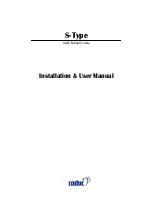
© Copyright 2019 TRENDnet. All Rights Reserved.
TRENDnet User’s Guide
TL2-FG142
12
Click to save changes.
Click to undo any changes made locally and revert to previously saved values.
4.3.1.5 Log
Configure System Log on this page.
Items
Description
Server
Mode
Indicates the server mode operation. When the mode operation is enabled, the syslog
message will send out to syslog server. The syslog protocol is based on UDP
communication and received on UDP port 514 and the syslog server will not send
acknowledgments back sender since UDP is a connectionless protocol and it does not
provide acknowledgments. The syslog packet will always send out even if the syslog
server does not exist. Possible modes are:
Enabled: Enable server mode operation.
Disabled: Disable server mode operation.
Server
Address
Indicates the IPv4 host address of syslog server. If the switch provide DNS
feature, it also can be a host name.
Syslog
Level
Indicates what kind of message will send to syslog server. Possible modes are:
Info: Send information, warnings and errors.
Warning: Send warnings and errors.
Error: Send errors.
Button
Click to save changes.
Click to undo any changes made locally and revert to previously saved values.
4.3.2 Green Ethernet
Green Ethernet is a feature that reduces energy consumption on the switch. This way,
the switch is more environmentally friendly, and your costs to run the switch are
reduced. This section explains how to configure Green Ethernet on the Managed Switch.
4.3.2.1 Port Power Savings
Before introduce this feature, let us talk about EEE.
What is EEE?
EEE is a power saving option that reduces the power usage when there is low or no
traffic utilization.
EEE works by powering down circuits when there is no traffic. When a port gets data to
be transmitted all circuits are powered up. The time it takes to power up the circuits is
named wakeup time. The default wakeup time is 17 us for 1Gbit links and 30 us for
other link speeds. EEE devices must agree upon the value of the wakeup time in order to
make sure that both the receiving and transmitting device has all circuits powered up
when traffic is transmitted. The devices can exchange wakeup time information using
the LLDP protocol.
EEE works for ports in auto-negotiation mode, where the port is negotiated to either 1G
or 100 Mbit full duplex mode.
For ports that are not EEE-capable the corresponding EEE checkboxes are grayed out
and thus impossible to enable EEE for.
When a port is powered down for saving power, outgoing traffic is stored in a buffer
until the port is powered up again. Because there are some overhead in turning the port
down and up, more power can be saved if the traffic can be buffered up until a large
burst of traffic can be transmitted. Buffering traffic will give some latency in the traffic.
This page allows the user to configure the port power savings features.
Содержание TL2-FG142
Страница 1: ...TRENDnet User s Guide Cover Page...
Страница 123: ...Copyright 2019 TRENDnet All Rights Reserved TRENDnet User s Guide TL2 FG142 118 Click to delete configuration file...
Страница 127: ...Copyright 2019 TRENDnet All Rights Reserved TRENDnet User s Guide TL2 FG142 122 Certifications CE FCC UL...
Страница 134: ......
















































